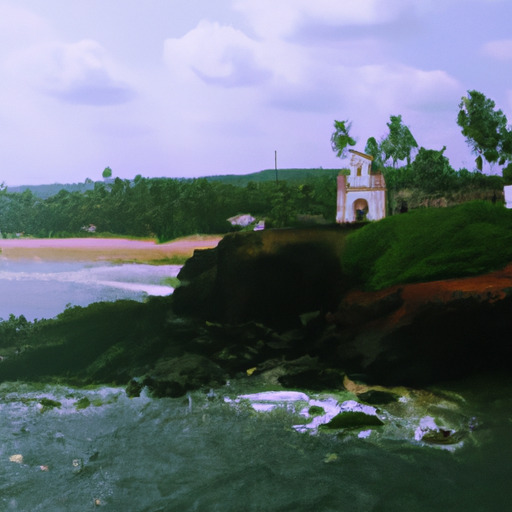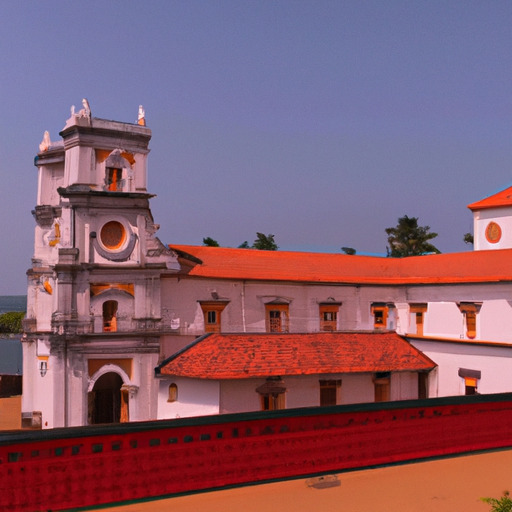Table of Contents
-
- Introduction
- Investigating the Legacy of Portuguese Language in Goa
- The Role of the Catholic Church in Preserving Goa’s Portuguese Heritage
- Uncovering the History of Portuguese Colonization in Goa
- The Impact of Portuguese Architecture on Goan Landscapes
- Exploring the Portuguese Influence on Goan Cuisine
- Q&A
- Conclusion
“Explore Goa’s Rich History – Uncover its Portuguese Roots!”
Introduction
Goa is a beautiful state in India, known for its stunning beaches, vibrant culture, and delicious cuisine. But what many people don’t know is that History of Portuguese Ancestors in Goa. The Portuguese ruled Goa for over 450 years, and their influence is still visible in the region’s architecture, language, and culture.. Exploring Goa’s Portuguese roots is a great way to learn more about the history of the region and gain a deeper appreciation for its unique culture. From the ruins of old forts to the delicious Portuguese-style dishes, there are plenty of ways to discover Goa’s Portuguese roots. Additionally, book Goa 5 Days Tour Package and explore History of Portuguese Ancestors in Goa.
Investigating the Legacy of Portuguese Language in Goa
Goa is a beautiful state in India that has a unique and fascinating history. Once a Portuguese colony, the region still bears the legacy of the Portuguese language today.
The Portuguese first arrived in Goa in 1510, and they quickly established a strong presence in the region. They brought their language, culture, and religion, and Goa still shows these influences today
For over 450 years, Goa recognized Portuguese as its official language, which the local population widely spoke. Despite the Portuguese departure in 1961, the language persisted in the region. Presently, many Goans speak Portuguese, and some schools still teach it
The Portuguese language has also left its mark on the local culture. Many of the local dishes reflect Portuguese influences, which have heavily shaped the local architecture and music. Furthermore, people often sing traditional songs in Portuguese
The legacy of the Portuguese language in Goa is an important part of the region’s history and culture. It is a reminder of the long and complex relationship between India and Portugal, and it is a testament to the lasting impact of the Portuguese language in the region.
The Role of the Catholic Church in Preserving Goa’s Portuguese Heritage
The Catholic Church has played an important role in preserving Goa’s Portuguese heritage. Goa was a Portuguese colony for over 450 years, and the Catholic Church was a major part of the Portuguese presence in the region. The Church has been instrumental in preserving the Portuguese language, culture, and architecture in Goa.
The Catholic Church has been a major force in preserving the Portuguese language in Goa. Many Goans still speak Portuguese, and the Church plays an instrumental role in keeping the language alive. Moreover, the Church preserves Portuguese literature, music, and art
The Catholic Church has also been a major force in preserving the culture of Goa. The Church preserves traditional Portuguese festivals, such as the Feast of St. Francis Xavier, and traditional Portuguese cuisine.
Finally, the Catholic Church has been a major force in preserving the architecture of Goa. The Church has actively preserved Portuguese language, culture, and architecture in Goa, and restored many Portuguese-era buildings, ensuring they remain a part of Goa’s cultural heritage.
The Catholic Church has been an important part of preserving Goa’s Portuguese heritage.The Church has actively preserved Portuguese language, culture, and architecture in Goa, and restored many Portuguese-era buildings, ensuring they remain a part of Goa’s cultural heritage.. The Church has been instrumental in preserving Goa’s Portuguese heritage for future generations.
Uncovering the History of Portuguese Ancestors in Goa

Goa is a small state located on the western coast of India, and it has a long and fascinating History of Portuguese Ancestors in Goa. The Portuguese maintained a strong presence in Goa for over 450 years, and their influence continues to be visible today. In this article, we’ll explore the history of Portuguese colonization in Goa and how it has shaped the region.
Explorer Afonso de Albuquerque
The Portuguese first arrived in Goa in 1510, led by explorer Afonso de Albuquerque. The Portuguese king sent him to establish a trading post in the region. Albuquerque quickly took control of the area and established a Portuguese colony. The Portuguese then began to expand their control over the region, and by 1543, they had taken control of the entire state.
The Portuguese brought with them their own culture, language, and religion. They built churches, schools, and other public buildings, and they also introduced new crops and farming techniques. The Portuguese also brought with them the Catholic faith, which is still the dominant religion in Goa today.
The Portuguese also had a major impact on the economy of Goa. They established a lucrative spice trade, which brought wealth to the region. They also introduced new industries such as shipbuilding and textiles.
Independence from Britain
The Portuguese rule in Goa lasted until 1961, when India gained independence from Britain. During this time, the Portuguese had a strong influence on the culture and economy of Goa. Some parts of the state still speak the Portuguese language today, and the Portuguese era saw the construction of many public buildings and monuments that remain standing
Goan Ancestral Ties to Portugal is an important part of the region’s history. It has shaped the culture, economy, and religion of the region, and it is still visible today. If you ever visit Goa, be sure to take some time to explore the history of Portuguese colonization and appreciate the lasting impact it has had on the region.
The Impact of Portuguese Architecture on Goan Landscapes
Goa is a beautiful state in India, known for its stunning beaches, lush green landscapes, and unique culture. It is also home to some of the most impressive Portuguese architecture in the world. Portuguese architecture has had a major impact on the Goan landscape, and it is one of the most distinctive features of the region.
Portuguese Arrived in Goa
The Portuguese arrived in Goa in the 16th century and quickly set about establishing their presence in the region. They built a number of impressive churches, forts, and other structures, which still stand today. These structures are a testament to the skill and creativity of the Portuguese architects who designed them.
The Portuguese architecture in Goa features bright colors, ornate designs, and intricate details. Intricate carvings and sculptures decorate the buildings, enhancing their beauty. The architecture also features a variety of styles, from Baroque to Gothic to Renaissance.
Goan landscape
The Portuguese architecture has had a major impact on the Goan landscape. The buildings often become the focal point of the landscape, and people can see them from miles away. The bright colors and intricate details of the buildings stand out against the lush green landscape, creating a stunning visual effect.
Culture of Goa
The Portuguese architecture has also had an impact on the culture of Goa. People often use the buildings as places of worship, and they remind us of the Portuguese influence in the region.. The architecture also serves as a reminder of the history of the region, and it is a source of pride for many Goans.
History of Portuguese Ancestors in Goa is a unique and beautiful part of the landscape. It has had a major impact on the region, and it is a reminder of the rich history and culture of the region. The buildings are a testament to the skill and creativity of the Portuguese architects who designed them, and they are a source of pride for many Goans.
Exploring the Portuguese Influence on Goan Cuisine
Goan cuisine is a unique blend of Indian and Portuguese flavors, reflecting the centuries of Portuguese rule in the region. The Portuguese influence on Goan cuisine is unmistakable, and it has resulted in some of the most delicious dishes in India.
The Portuguese brought with them a variety of ingredients, including potatoes, tomatoes, and chillies, which are now staples of Goan cuisine. and also introduced the use of vinegar to marinate meats and fish. They also brought a variety of spices such as cinnamon, cloves, and nutmeg, which now flavor many Goan dishes.
The Portuguese influence is also evident in the use of pork in Goan cuisine. Pork dishes such as vindaloo, sorpotel, and chouriço are all popular in Goa. People usually serve these dishes with rice or bread and frequently pair them with an assortment of vegetables.
The Portuguese also introduced the use of wine and brandy in Goan cooking. People use these to marinate meats and fish and to add flavor to dishes. People also use wine to make a variety of sauces, such as the popular Goan Xacuti sauce
The Portuguese influence is also evident in the use of seafood in Goan cuisine. People cook fish and shellfish using a variety of methods, such as currying, stewing, and frying. The Portuguese introduced the use of coconut milk, which people now use to prepare diverse curries and sauces.
Goan cuisine is a unique blend of Indian and Portuguese flavors, and it is a testament to the centuries of Portuguese rule in the region. The Portuguese influence is evident in the use of ingredients, spices, and cooking techniques, and it has resulted in some of the most delicious dishes in India.
Q&A
Q1: What is the history of Portuguese influence in Goa?
A1: Portuguese influence in Goa dates back to the 16th century when the Portuguese arrived in India and established a trading post in the region. The Portuguese then went on to colonize Goa in 1510, and their influence remained until 1961 when India liberated the region.
Q2: What are some of the cultural influences that the Portuguese left behind in Goa?
A2: The Portuguese left behind a number of cultural influences in Goa, including the Portuguese language, architecture, cuisine, and religion. Many Goans still practice Christianity, which the Portuguese introduced to the region.
Q3: What are some of the most popular tourist attractions in Goa related to its Portuguese roots?
A3: Some of the most popular tourist attractions related to Goa’s Portuguese roots include the Basilica of Bom Jesus, the Se Cathedral, and the Church of St. Francis of Assisi. Other popular attractions include the Old Goa Museum, the Aguada Fort, and the Reis Magos Fort.
Q4: How has Portuguese cuisine influenced some of the traditional dishes in Goa?
A4: Portuguese cuisine has influenced some of the traditional dishes in Goa, such as vindaloo, xacuti, and sorpote.Other popular dishes include balchão, cafreal, and bebinca.
Q5: What are some of the festivals in Goa that celebrate its Portuguese heritage?
A5: Some of the festivals in Goa that celebrate its Portuguese heritage include the Feast of St. Francis Xavier, the Feast of Our Lady of Miracles, and the Feast of St. Anthony. Other popular festivals include the Intruz Festival, the Carnival of Goa, and the Feast of St. John the Baptist.
Q6: What is the History of Portuguese Ancestors in Goa?
A6: Goa was a Portuguese colony from 1510 until 1961. During this period, the Portuguese left a lasting imprint on the region, which is still visible today. The Portuguese established trading posts in Goa in the early 16th century, and over time they gained control of the region through a series of wars.
Conclusion
The Portuguese has wide Influence on Goan History From the architecture to the cuisine, the influence of the Portuguese is evident in many aspects of life in Goa. Exploring the Portuguese roots of Goa is a great way to gain a deeper understanding of the region and its people. It is a journey that will take you back in time and provide you with a unique insight into the history and culture of this beautiful part of India.
Please Read out: Discover the Rich History and Culture of Goa



0 Comment